In
an earlier post, I showed how KML can be used to create 3D choropleth maps or
prism maps. A prism map is a statistical surface map viewed in perspective (1). It's the recommended way of visualising numerical data using choropleth mapping (2). See these examples showing internet users in the world:

This choropleth map shows the number of internet users per 100 population in 2005 (see
this post for more information about the map). Even though it's possible to see that one shade is lighter or darker than another, it's impossible to see that the shade for one country is twice as dark as another. It's better to use this type of choropleth maps with
nominal or
ordinal data, and not numerical data (
interval or
ratio measurements).

This image shows the same data
visualised in Google Earth (the problem with holes in extruded polygons
is described here). The height (and colour) is proportional to the percentage of internet users. This prism map portray ratios correctly, - a country having twice as many internet users (in percent) as another will be represented by a prism twice as high. The advantage of using Google Earth is that the globe is easily rotatable in all directions, and the user can thereby avoid the problem that tall prisms sometimes block smaller prism. But the globe view can also be challenging, as it's not possible to see the whole world at a glance.
 UUorld
UUorld has specialised in animated prism maps. Instead of using a globe, the units are extruded from a flat surface. The surface can be zoomed, tilted and rotated in every direction.
This video shows the capabilities of UUorld, and also an alternative view when visualising raw totals instead of percentages. I will later show how prism maps can be animated in Google Earth.
An alternative to prism maps is to use
proportional symbols or
pie charts. The size of the chart could be proportional to the total population, while the pie chart could show the percentage of internet users.
References
1.
Multimedia Cartography, 1995, William Cartwright, Michael P. Peterson and Georg Gartner, Springer
2.
Thematic Cartography and Geographic Visualization, Second Edition 2005, Terry A. Slocum et al., Pearson Education, Inc
 The legend and map title shown in this screenshot are created using PHP-GD image functions, stored in a KMZ archive as PNG images, and added as screen overlays. You can download the KMZ file here.
The legend and map title shown in this screenshot are created using PHP-GD image functions, stored in a KMZ archive as PNG images, and added as screen overlays. You can download the KMZ file here.



